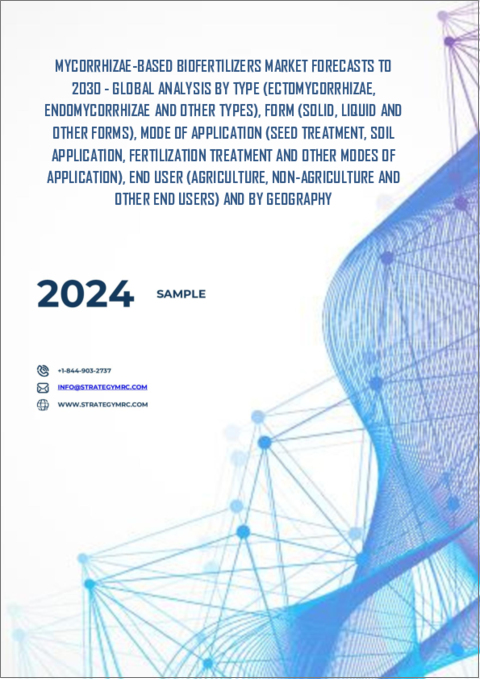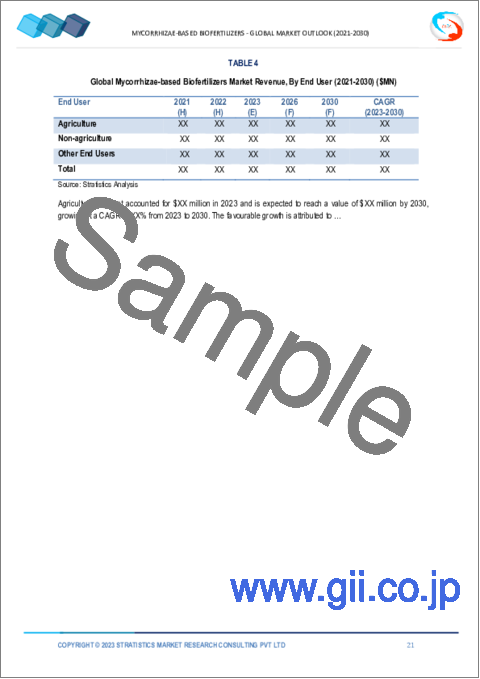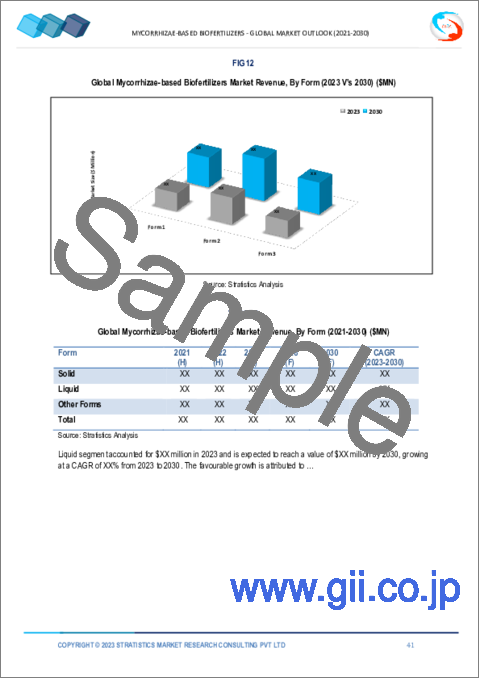|
|
市場調査レポート
商品コード
1339957
菌根菌ベースのバイオ肥料市場の2030年までの予測- タイプ別、形態別、適用形態別、用途別、地域別の世界分析Mycorrhizae-based Biofertilizers Market Forecasts to 2030 - Global Analysis By Type, Form, Mode of Application, Application and By Geography |
||||||
カスタマイズ可能
|
|||||||
| 菌根菌ベースのバイオ肥料市場の2030年までの予測- タイプ別、形態別、適用形態別、用途別、地域別の世界分析 |
|
出版日: 2023年08月01日
発行: Stratistics Market Research Consulting
ページ情報: 英文 175+ Pages
納期: 2~3営業日
|
- 全表示
- 概要
- 図表
- 目次
Stratistics MRCによると、世界の菌根菌ベースのバイオ肥料市場は、2023年に3億8,360万米ドルを占め、予測期間中に18.8%のCAGRで成長し、2030年までに12億8,114万米ドルに達すると予想されています。
菌根菌と呼ばれる菌類は、土壌や高等植物の根に生息しています。菌根菌は、宿主を特定しない形で植物の根と結合します。菌根菌として知られる真菌は、非維管束性の宿主植物の根と共生関係を作る。植物の根と土壌菌は、菌根菌を通して共生的、相互的に作用します。栄養分の取り込みを改善し、成長ホルモンを促進することで、菌根菌ベースのバイオ肥料は植物の成長を刺激します。
国連人口部によると、世界の人口は2050年に97億人、2100年頃には約110億人に達すると予想されています。その結果、世界中で高まる食糧需要を満たすために、農業生産が積極的に奨励されなければなりません。
市場力学:
促進要因
- 有機食品への需要の高まり
- 菌根菌ベースのバイオ肥料の需要は、有機食品の消費を通じて健康的なライフスタイルを維持する必要性と、土壌汚染を減らすための有機農法への需要の高まりによって牽引されると予想されます。さらに、健康的な食品に対する需要の高まりと農業業界による有機野菜の生産は、発展途上国における農村部の貧困と失業の削減に役立つ可能性があります。市場の成長は、有機野菜や果物の生産が促進された結果、菌根菌ベースのバイオ肥料に対する需要が増加し、環境にも好影響を与えることに起因しています。
抑制要因
- 生産コストの高さ
- 菌根菌ベースのバイオ肥料の世界市場の成長は、これらの肥料の高い生産コストによって制約されると予測されます。菌根菌ベースのバイオ肥料は、高価な機械と熟練した労働力を必要とする複雑な製造手順を用いて作られます。さらに、担体材料や菌類の胞子のような、これらのバイオ肥料を作るために使用される原材料のコストも高いです。このため、バイオ肥料の最終コストは相対的に高くなり、小規模農家が使用するには割高になります。小規模農家は地域を問わず農業コミュニティのかなりの部分を占めているため、これは市場拡大の大きな障壁となりうる。
機会
- 作物の生産性と収量の増加
- 菌根菌ベースのバイオ肥料は、現代農業における重要なツールとして登場し、作物の生産性向上、農場の収益性向上、優れた収量に貢献しています。これらのバイオ肥料は、植物の根との共生関係を促進することにより、植物の成長とより健康な根系を増加させる。これにより、養分の吸収と生産性が向上します。また、化学肥料とは対照的に、養分の利用可能性と保水性を高め、土壌の長期的な健全性を向上させる。さらに、菌根菌と共生する植物は環境ストレスに強くなるため、菌根菌ベースのバイオ肥料は植物の気候変動への適応を助けます。生産性、土壌の健全性、気候変動への耐性を向上させながら、より環境に優しい未来のための持続可能な慣行と調和させることで、菌根菌ベースのバイオ肥料は農業に革命をもたらします。
脅威
- 知識と教育の欠如
- 菌根菌ベースのバイオ肥料は非常に大きな可能性を秘めているにもかかわらず、農家の認識と教育の欠如が、現代農業における普及の大きな障害となっています。多くの農業関係者は、これらのバイオ肥料の利点や適切な施用方法についてまだよく分かっておらず、そのため懐疑的で、農法に取り入れることに抵抗を感じています。さらに、この知識不足は、作物生産性に対する菌根菌共生の利点が効果的に伝えられていないことなどが影響しています。さらに農民は、正式な研修や普及サービスがないため、菌根菌ベースのバイオ肥料を使用するための具体的な要件やベストプラクティスを理解することができないです。
COVID-19の影響
- 菌根菌ベースのバイオ肥料の世界市場は、COVID-19のパンデミックによって、ポジティブな意味でもネガティブな意味でも影響を受けた。プラス面では、パンデミックによって有機食品の需要が増加し、それによって菌根菌ベースのバイオ肥料の需要も増加しました。消費者が健康に気を配るようになり、農薬や危険な化学物質を使わない食品を求めるようになったからです。原料不足と生産の遅れはパンデミックによってもたらされ、世界のサプライチェーンも混乱しました。菌根菌をベースとするバイオ肥料はコストが高くなり、農家、特に小規模農家には手が届かなくなっています。
- 予測期間中、液体分野が最大となる見込み
- 予測期間中、菌根菌ベースのバイオ肥料市場の液体セグメントが最大の市場シェアを占めると予想されます。液体バイオ肥料は使用が簡単で、植物の根や葉から素早く吸収されるため、成長が早く収量が向上します。さらに、液体バイオ肥料は固形製剤よりも保存期間が長いため、保管や輸送も容易です。特定の植物の生育要件によりよく対応するために、液体バイオ肥料は特定の栄養剤の配合で調整することができます。菌根菌ベースのバイオ肥料の世界市場において、これらの要素は液体セグメントの人気獲得と拡大に役立っています。
- 農業分野は予測期間中に最も高いCAGRが見込まれる
- 農業分野は、予測期間中に最も高いCAGRが見込まれます。農業分野には多種多様な作物や農業技術が含まれ、菌根菌をベースとしたものを含むバイオ肥料の重要なユーザーです。菌根菌ベースのバイオ肥料は、土壌の健全性を向上させ、作物の収量を増やし、持続可能な農法を実践するために、穀物、油糧種子、豆類、果物、野菜などのサブセクターの農家によってますます使用されるようになっています。さらに、これらのバイオ肥料は非常に有益であることが証明されており、養分の取り込み、水の吸収、植物全体の成長を促進するため、環境に優しく効果的な農業ソリューションを重視する業界の成長を支えています。
最大のシェアを占める地域:
予想される期間中、北米が菌根菌ベースのバイオ肥料市場において最大のシェアを占めるであろう。この地域の優位性は、バイオ肥料と持続可能な農業技術をいち早く導入した米国とカナダによるところが大きいです。さらに、菌根菌ベースのバイオ肥料は、環境意識の高まり、有機製品に対する需要の高まり、研究開発活動、支持的な政府政策、および重要な市場プレイヤーの存在などの追加要因の結果として、北米でますます採用されています。
CAGRが最も高い地域:
菌根菌ベースのバイオ肥料市場は、予測期間中に欧州で最も高いCAGRを持つと予想されます。菌根菌ベースのバイオ肥料は、この地域の持続可能な農業の受け入れと有機商品への需要の高まりにより、ますます人気が高まっています。さらに、有機農業を支援し、化学物質の使用を制限する厳しい規制も、欧州での市場拡大に寄与しています。欧州では持続可能な農業が重視されているため、菌根菌をベースとしたバイオ肥料の需要は増加すると予想されます。
無料カスタマイズサービス:
本レポートをご購読のお客様には、以下のいずれかの無料カスタマイズオプションをご提供いたします:
- 企業プロファイル
- 追加市場プレイヤーの包括的プロファイリング(3社まで)
- 主要企業のSWOT分析(3社まで)
- 地域セグメンテーション
- 顧客の関心に応じた主要国の市場推計・予測・CAGR(注:フィージビリティチェックによる)
- 競合ベンチマーキング
- 製品ポートフォリオ、地理的プレゼンス、戦略的提携に基づく主要企業のベンチマーキング
目次
第1章 エグゼクティブサマリー
第2章 序文
- エグゼクティブサマリー
- ステークホルダー
- 調査範囲
- 調査手法
- データマイニング
- データ分析
- データ検証
- 調査アプローチ
- 調査ソース
- 一次調査情報源
- 二次調査情報源
- 前提条件
第3章 市場動向分析
- 促進要因
- 抑制要因
- 機会
- 脅威
- アプリケーション分析
- 新興市場
- COVID-19の影響
第4章 ポーターのファイブフォース分析
- 供給企業の交渉力
- 買い手の交渉力
- 代替品の脅威
- 新規参入業者の脅威
- 競争企業間の敵対関係
第5章 菌根菌ベースのバイオ肥料の世界市場:タイプ別
- 外菌根菌
- 菌根菌
- その他のタイプ
第6章 菌根菌ベースのバイオ肥料の世界市場:形態別
- 固体
- 粉末
- 顆粒
- 液体
- その他の形態
第7章 菌根菌ベースのバイオ肥料の世界市場:適用形態別
- 種子処理
- 土壌施用
- 施肥処理
- その他の適用形態
第8章 菌根菌ベースのバイオ肥料の世界市場:用途別
- 農業
- 穀物
- トウモロコシ
- 小麦
- 米
- 穀物
- 油糧種子・豆類
- 大豆
- 綿花
- 果物・野菜
- リンゴ
- 梨
- キュウリ
- ジャガイモ
- ブドウ
- 農業以外
- その他の用途
第9章 菌根菌ベースのバイオ肥料の世界市場:地域別
- 北米
- 米国
- カナダ
- メキシコ
- 欧州
- ドイツ
- 英国
- イタリア
- フランス
- スペイン
- その他欧州
- アジア太平洋
- 日本
- 中国
- インド
- オーストラリア
- ニュージーランド
- 韓国
- その他アジア太平洋地域
- 南米
- アルゼンチン
- ブラジル
- チリ
- その他南米
- 中東・アフリカ
- サウジアラビア
- アラブ首長国連邦
- カタール
- 南アフリカ
- その他中東とアフリカ
第10章 主な発展
- 契約、パートナーシップ、提携、合弁事業
- 買収と合併
- 新製品の上市
- 事業拡大
- その他の主要戦略
第11章 企業プロファイル
- Lallemand Inc.
- Helena Agri-Enterprises, LLC
- Agrinos Inc.
- Sikko Industries
- Biolchim SPA
- Privi Life Sciences
- Indogulf BioAg LLC
- Plant Health Care Plc.
- Koppert Biological Systems Inc.
- Agrilife Limited
- Novozymes A/S
- Premier Tech Ltd.
- Sustane Natural Fertilizer Inc
- UPL Limited
- Valent Biosciences LLC
- Agrotecnologias Naturales Atens
- Biostadt India Limited
- Vegalab S.A.
- Tainio Biologicals, Inc.
- Groundwork AG
List of Tables
- Table 1 Global Mycorrhizae-based Biofertilizers Market Outlook, By Region (2021-2030) ($MN)
- Table 2 Global Mycorrhizae-based Biofertilizers Market Outlook, By Type (2021-2030) ($MN)
- Table 3 Global Mycorrhizae-based Biofertilizers Market Outlook, By Ectomycorrhizae (2021-2030) ($MN)
- Table 4 Global Mycorrhizae-based Biofertilizers Market Outlook, By Endomycorrhizae (2021-2030) ($MN)
- Table 5 Global Mycorrhizae-based Biofertilizers Market Outlook, By Other Types (2021-2030) ($MN)
- Table 6 Global Mycorrhizae-based Biofertilizers Market Outlook, By Form (2021-2030) ($MN)
- Table 7 Global Mycorrhizae-based Biofertilizers Market Outlook, By Solid (2021-2030) ($MN)
- Table 8 Global Mycorrhizae-based Biofertilizers Market Outlook, By Powder (2021-2030) ($MN)
- Table 9 Global Mycorrhizae-based Biofertilizers Market Outlook, By Granules (2021-2030) ($MN)
- Table 10 Global Mycorrhizae-based Biofertilizers Market Outlook, By Liquid (2021-2030) ($MN)
- Table 11 Global Mycorrhizae-based Biofertilizers Market Outlook, By Other Forms (2021-2030) ($MN)
- Table 12 Global Mycorrhizae-based Biofertilizers Market Outlook, By Mode of Application (2021-2030) ($MN)
- Table 13 Global Mycorrhizae-based Biofertilizers Market Outlook, By Seed Treatment (2021-2030) ($MN)
- Table 14 Global Mycorrhizae-based Biofertilizers Market Outlook, By Soil Application (2021-2030) ($MN)
- Table 15 Global Mycorrhizae-based Biofertilizers Market Outlook, By Fertilization Treatment (2021-2030) ($MN)
- Table 16 Global Mycorrhizae-based Biofertilizers Market Outlook, By Other Modes of Application (2021-2030) ($MN)
- Table 17 Global Mycorrhizae-based Biofertilizers Market Outlook, By Application (2021-2030) ($MN)
- Table 18 Global Mycorrhizae-based Biofertilizers Market Outlook, By Agriculture (2021-2030) ($MN)
- Table 19 Global Mycorrhizae-based Biofertilizers Market Outlook, By Cereals & Grains (2021-2030) ($MN)
- Table 20 Global Mycorrhizae-based Biofertilizers Market Outlook, By Oilseeds & Pulses (2021-2030) ($MN)
- Table 21 Global Mycorrhizae-based Biofertilizers Market Outlook, By Soyabean (2021-2030) ($MN)
- Table 22 Global Mycorrhizae-based Biofertilizers Market Outlook, By Cotton (2021-2030) ($MN)
- Table 23 Global Mycorrhizae-based Biofertilizers Market Outlook, By Fruits & Vegetables (2021-2030) ($MN)
- Table 24 Global Mycorrhizae-based Biofertilizers Market Outlook, By Apple (2021-2030) ($MN)
- Table 25 Global Mycorrhizae-based Biofertilizers Market Outlook, By Pears (2021-2030) ($MN)
- Table 26 Global Mycorrhizae-based Biofertilizers Market Outlook, By Cucumber (2021-2030) ($MN)
- Table 27 Global Mycorrhizae-based Biofertilizers Market Outlook, By Potatoes (2021-2030) ($MN)
- Table 28 Global Mycorrhizae-based Biofertilizers Market Outlook, By Grapes (2021-2030) ($MN)
- Table 29 Global Mycorrhizae-based Biofertilizers Market Outlook, By Non-agriculture (2021-2030) ($MN)
- Table 30 Global Mycorrhizae-based Biofertilizers Market Outlook, By Other Applications (2021-2030) ($MN)
Note: Tables for North America, Europe, APAC, South America, and Middle East & Africa Regions are also represented in the same manner as above.
According to Stratistics MRC, the Global Mycorrhizae-based Biofertilizers Market is accounted for $383.60 million in 2023 and is expected to reach $1281.14 million by 2030 growing at a CAGR of 18.8% during the forecast period. Fungi called mycorrhizae stay in the soil and roots of higher plants. They associate with plant roots in a non-host-specific way. A fungus known as mycorrhizae creates a symbiotic relationship with the roots of an avascular host plant. The roots of plants and soil fungi interact symbiotically and mutualistically through mycorrhizae. By improving nutrient uptake and fostering growth hormones, mycorrhiza-based bio fertilizers stimulate plant growth.
According to the UN population division, the world's population is expected to reach 9.7 billion people in 2050 and about 11 billion people around 2100. As a result, agricultural production must be actively encouraged to meet the growing need for food worldwide.
Market Dynamics:
Driver:
- Increasing demand for organic food.
- The demand for mycorrhizae-based biofertilizers is anticipated to be driven by the need to maintain a healthy lifestyle through the consumption of organic food and the growing demand for organic farming practices to reduce soil pollution. Additionally, the growing demand for healthy food and the farming industry's production of organic vegetables may help reduce rural poverty and unemployment in developing nations. The growth of the market can be attributed to the increase in demand for mycorrhizae-based biofertilizers as a result of promoting the production of organic fruits and vegetables, which also has positive effects on the environment.
Restraint:
- High cost for production.
- The growth of the global market for mycorrhiza-based biofertilizers is predicted to be constrained by the high production costs of these fertilizers. Mycorrhizae-based biofertilizers are made using intricate manufacturing procedures that demand expensive machinery and skilled labor. Additionally, the cost of the raw materials used to make these biofertilizers, such as the carrier materials and fungal spores, is also high. Due to this, the biofertilizer's final cost is relatively high, making it more expensive for small-scale farmers to use. Small-scale farmers make up a sizable portion of the agricultural community across regions, so this can be a significant barrier to the market's expansion.
Opportunity:
- Increase in crop productivity and yield.
- Mycorrhizae-based biofertilizers have emerged as a key tool in contemporary agriculture, contributing to improved crop productivity, increased farm profitability, and superior yields. These biofertilizers increase plant growth and healthier root systems by fostering a symbiotic relationship with plant roots. This increases nutrient absorption and productivity. They enhance nutrient availability and water retention, improving long-term soil health in contrast to chemical fertilizers. Additionally, mycorrhizae-based biofertilizers help plants adapt to climate change because mycorrhizal-associated plants are more resilient to environmental stresses. By improving productivity, soil health, and climate resilience while aligning with sustainable practices for a greener future, mycorrhizae-based biofertilizers revolutionize agriculture.
Threat:
- Lack of knowledge and education.
- Despite mycorrhizae-based biofertilizers' enormous potential, farmers' lack of awareness and education pose a significant obstacle to their widespread adoption in modern agriculture. Many agricultural professionals are still unsure of the advantages and proper application of these biofertilizers, which causes skepticism and resistance to incorporating them into farming practices. Moreover, this lack of knowledge is influenced by things like the ineffective communication of the benefits of mycorrhizal symbiosis for crop productivity. Farmers are further prevented from understanding the specific requirements and best practices for using mycorrhizae-based biofertilizers by the lack of formal training and extension services.
COVID-19 Impact:
- The global market for mycorrhiza-based biofertilizers was impacted by the COVID-19 pandemic in both positive and negative ways. Positively, the pandemic increased demand for organic food items, which in turn increased demand for mycorrhiza-based biofertilizers. It's because consumers are becoming more concerned with their health and are seeking out food items free of pesticides and dangerous chemicals. A shortage of raw materials and production delays were brought on by the pandemic, which also disrupted the world's supply chain. Mycorrhiza-based biofertilizers now cost more, making them more out of reach for farmers, particularly small-scale farmers.
- The liquid segment is expected to be the largest during the forecast period
- During the anticipated period, the liquid segment of the market for mycorrhiza-based biofertilizers is anticipated to account for the largest market share. Liquid biofertilizers are simple to use and can be quickly absorbed by plants through the roots or leaves, resulting in quicker growth and better yields. Moreover, liquid biofertilizers are also easier to store and transport because they have a longer shelf life than solid formulations. In order to better address particular plant growth requirements, liquid biofertilizers can be tailored with particular nutrient formulations. In the global market for mycorrhiza-based biofertilizers, these elements have helped the liquid segment gain popularity and expand.
- The agriculture segment is expected to have the highest CAGR during the forecast period
- The agriculture segment is anticipated to have the highest CAGR during the forecast period. Agriculture sector includes a wide variety of crops and farming techniques and is a significant user of biofertilizers, including those based on mycorrhizae. Mycorrhizae-based biofertilizers are being used more and more by farmers in subsectors like cereals, oilseeds, pulses, fruits, and vegetables to improve soil health, increase crop yields, and practice sustainable farming methods. Additionally, these biofertilizers have proven to be highly beneficial, enhancing nutrient uptake, water absorption, and overall plant growth, thus supporting the industry's growing emphasis on eco-friendly and effective agricultural solutions.
Region with largest share:
During the anticipated period, North America will hold the largest market share for mycorrhizae-based biofertilizers. The region's prominence is due in part to the United States and Canada, which were early adopters of biofertilizers and sustainable agricultural techniques. Moreover, Mycorrhizae-based biofertilizers have been increasingly adopted in North America as a result of additional factors, including rising environmental awareness, rising demand for organic products, research and development activities, supportive governmental policies, and the presence of significant market players.
Region with highest CAGR:
The Mycorrhizae-based Biofertilizers Market is anticipated to have highest CAGR in Europe during the forecasted period. Mycorrhizae-based biofertilizers have become increasingly popular due to the region's embrace of sustainable agriculture and rising demand for organic goods. Furthermore, strict regulations supporting organic farming and limiting the use of chemicals also contribute to the market's expansion in Europe. The demand for biofertilizers based on mycorrhizae is expected to increase in Europe as the region places more emphasis on sustainable agriculture.
Key players in the market:
Some of the key players in Mycorrhizae-based Biofertilizers market include: Lallemand Inc., Helena Agri-Enterprises, LLC, Agrinos Inc., Sikko Industries, Biolchim SPA, Privi Life Sciences, Indogulf BioAg LLC, Plant Health Care Plc., Koppert Biological Systems Inc., Agrilife Limited, Novozymes A/S, Premier Tech Ltd., Sustane Natural Fertilizer Inc, UPL Limited, Valent Biosciences LLC, Agrotecnologias Naturales Atens, Biostadt India Limited, Vegalab S.A., Tainio Biologicals, Inc. and Groundwork AG.
Key Developments:
- In March 2023, Novozymes and Chr. Hansen held their respective extraordinary general meetings, and the shareholders of both companies approved the proposed merger. The new company will be science-based, with powerful capabilities and commercial excellence to develop biological solutions that will enable healthier lives, transform food systems, and accelerate towards a climate neutral society.
- In August 2022, Valent BioSciences subsidiary, Mycorrhizal Applications LLC, announced an expansion of its research facilities at the Bio Research & Development Growth Park at the Donald Danforth Plant Science Center in St. Louis, Missouri. The expansion would provide increased laboratory capacity for research related to arbuscular mycorrhizal fungi, as well as additional office and meeting space. The expansion will also allow the company to conduct in-depth research on new uses for mycorrhizae.
- In June 2022, Groundwork BioAg and Israel-based global crop protection company, ADAMA announced a commercial agreement offering sustainable, cost-effective mycorrhizal products to help increase crop yields in the Indian market. The collaboration would enable ADAMA and Groundwork BioAg to access India's vast and rapidly growing agricultural market. as soybean and corn. The product launch will help the company serve its Brazilian customers in a better way.
Types Covered:
- Ectomycorrhizae
- Endomycorrhizae
- Other Types
Forms Covered:
- Solid
- Liquid
- Other Forms
Modes of Application Covered:
- Seed Treatment
- Soil Application
- Fertilization Treatment
- Other Modes of Application
Applications Covered:
- Agriculture
- Oilseeds & Pulses
- Fruits & Vegetables
- Non-agriculture
- Other Applications
Regions Covered:
- North America
- US
- Canada
- Mexico
- Europe
- Germany
- UK
- Italy
- France
- Spain
- Rest of Europe
- Asia Pacific
- Japan
- China
- India
- Australia
- New Zealand
- South Korea
- Rest of Asia Pacific
- South America
- Argentina
- Brazil
- Chile
- Rest of South America
- Middle East & Africa
- Saudi Arabia
- UAE
- Qatar
- South Africa
- Rest of Middle East & Africa
What our report offers:
- Market share assessments for the regional and country-level segments
- Strategic recommendations for the new entrants
- Covers Market data for the years 2021, 2022, 2023, 2026, and 2030
- Market Trends (Drivers, Constraints, Opportunities, Threats, Challenges, Investment Opportunities, and recommendations)
- Strategic recommendations in key business segments based on the market estimations
- Competitive landscaping mapping the key common trends
- Company profiling with detailed strategies, financials, and recent developments
- Supply chain trends mapping the latest technological advancements
Free Customization Offerings:
All the customers of this report will be entitled to receive one of the following free customization options:
- Company Profiling
- Comprehensive profiling of additional market players (up to 3)
- SWOT Analysis of key players (up to 3)
- Regional Segmentation
- Market estimations, Forecasts and CAGR of any prominent country as per the client's interest (Note: Depends on feasibility check)
- Competitive Benchmarking
- Benchmarking of key players based on product portfolio, geographical presence, and strategic alliances
Table of Contents
1 Executive Summary
2 Preface
- 2.1 Abstract
- 2.2 Stake Holders
- 2.3 Research Scope
- 2.4 Research Methodology
- 2.4.1 Data Mining
- 2.4.2 Data Analysis
- 2.4.3 Data Validation
- 2.4.4 Research Approach
- 2.5 Research Sources
- 2.5.1 Primary Research Sources
- 2.5.2 Secondary Research Sources
- 2.5.3 Assumptions
3 Market Trend Analysis
- 3.1 Introduction
- 3.2 Drivers
- 3.3 Restraints
- 3.4 Opportunities
- 3.5 Threats
- 3.6 Application Analysis
- 3.7 Emerging Markets
- 3.8 Impact of Covid-19
4 Porters Five Force Analysis
- 4.1 Bargaining power of suppliers
- 4.2 Bargaining power of buyers
- 4.3 Threat of substitutes
- 4.4 Threat of new entrants
- 4.5 Competitive rivalry
5 Global Mycorrhizae-based Biofertilizers Market, By Type
- 5.1 Introduction
- 5.2 Ectomycorrhizae
- 5.3 Endomycorrhizae
- 5.4 Other Types
6 Global Mycorrhizae-based Biofertilizers Market, By Form
- 6.1 Introduction
- 6.2 Solid
- 6.2.1 Powder
- 6.2.2 Granules
- 6.3 Liquid
- 6.4 Other Forms
7 Global Mycorrhizae-based Biofertilizers Market, By Mode of Application
- 7.1 Introduction
- 7.2 Seed Treatment
- 7.3 Soil Application
- 7.4 Fertilization Treatment
- 7.5 Other Modes of Application
8 Global Mycorrhizae-based Biofertilizers Market, By Application
- 8.1 Introduction
- 8.2 Agriculture
- 8.2.1 Cereals & Grains
- 8.2.1.1 Corn
- 8.2.1.2 Wheat
- 8.2.1.3 Rice
- 8.2.1 Cereals & Grains
- 8.3 Oilseeds & Pulses
- 8.3.1 Soyabean
- 8.3.2 Cotton
- 8.4 Fruits & Vegetables
- 8.4.1 Apple
- 8.4.2 Pears
- 8.4.3 Cucumber
- 8.4.4 Potatoes
- 8.4.5 Grapes
- 8.5 Non-agriculture
- 8.6 Other Applications
9 Global Mycorrhizae-based Biofertilizers Market, By Geography
- 9.1 Introduction
- 9.2 North America
- 9.2.1 US
- 9.2.2 Canada
- 9.2.3 Mexico
- 9.3 Europe
- 9.3.1 Germany
- 9.3.2 UK
- 9.3.3 Italy
- 9.3.4 France
- 9.3.5 Spain
- 9.3.6 Rest of Europe
- 9.4 Asia Pacific
- 9.4.1 Japan
- 9.4.2 China
- 9.4.3 India
- 9.4.4 Australia
- 9.4.5 New Zealand
- 9.4.6 South Korea
- 9.4.7 Rest of Asia Pacific
- 9.5 South America
- 9.5.1 Argentina
- 9.5.2 Brazil
- 9.5.3 Chile
- 9.5.4 Rest of South America
- 9.6 Middle East & Africa
- 9.6.1 Saudi Arabia
- 9.6.2 UAE
- 9.6.3 Qatar
- 9.6.4 South Africa
- 9.6.5 Rest of Middle East & Africa
10 Key Developments
- 10.1 Agreements, Partnerships, Collaborations and Joint Ventures
- 10.2 Acquisitions & Mergers
- 10.3 New Product Launch
- 10.4 Expansions
- 10.5 Other Key Strategies
11 Company Profiling
- 11.1 Lallemand Inc.
- 11.2 Helena Agri-Enterprises, LLC
- 11.3 Agrinos Inc.
- 11.4 Sikko Industries
- 11.5 Biolchim SPA
- 11.6 Privi Life Sciences
- 11.7 Indogulf BioAg LLC
- 11.8 Plant Health Care Plc.
- 11.9 Koppert Biological Systems Inc.
- 11.10 Agrilife Limited
- 11.11 Novozymes A/S
- 11.12 Premier Tech Ltd.
- 11.13 Sustane Natural Fertilizer Inc
- 11.14 UPL Limited
- 11.15 Valent Biosciences LLC
- 11.16 Agrotecnologias Naturales Atens
- 11.17 Biostadt India Limited
- 11.18 Vegalab S.A.
- 11.19 Tainio Biologicals, Inc.
- 11.20 Groundwork AG






